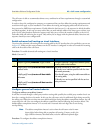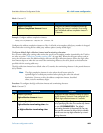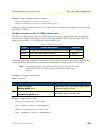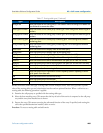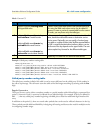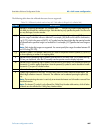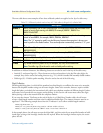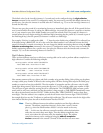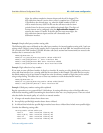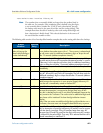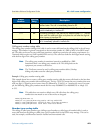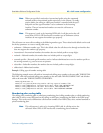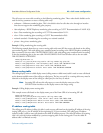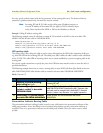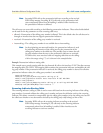
Call router configuration task list 469
SmartWare Software Configuration Guide 40 • Call router configuration
The default value for the interdigit timeout is 5 seconds and can be configured using the digit-collection
timeout
command in the context CS configuration mode. You may want to override this default timeout for a
specific entry. Just place the timeout in seconds after the T-indicator; e.g. T3 to set the inter digit timeout to 3
seconds for that entry.
The user may press the pound (#) as terminating character to immediately place the call. If the pound (#) char-
acter is entered while the router is waiting for additional digits, the pound (#) character is treated as a termina-
tor; it is not treated as part of the dialed number sent across the network. But if the pound (#) character is
entered before the router begins waiting for additional digits (meaning that the pound (#) is entered as part of
the fixed-length key), then the pound (#) character is treated as a dialed digit.
For example, if the key is configured as 888 . . . . T, then the entire dialed string of 888#2525 is collected, but
if the dialed string is 888#252#5, the #5 at the end of the dialed number is not collected, because the final
pound (#) character is treated as terminator. You can change the default terminating character using the
digit-
collection terminating-char
command in the context CS configuration mode. You may want to override this
default terminating character for a specific entry. Just place the character after the timeout and a comma; for
example, T3,* to set the terminating character to asterisk (*).
Digit Collection Variants
There are three different ways how a called party routing-table can be used to perform address completion or
digit collection. Consider the following examples:
routing-table called-e164 TAB-PREFIX
route 099 dest-interface IF-OUT
routing-table called-e164 TAB-COMPLETE
route 099.... dest-interface IF-OUT
routing-table called-e164 TAB-COLLECT
route 099T dest-interface IF-OUT
Now assume someone picks up a phone and dials a number using overlap dialing. After picking up the phone,
an empty called party number is offered to the routing tables. All three routing tables require the called party
number to contain at least the prefix 099. Thus the number is incomplete and the call router waits for addi-
tional digits being entered. Now the user presses the digit one (1). The resulting called party number is 0991.
The call router is again asked for routing the call to a destination. The TAB-PREFIX table performs a prefix
match with its only entry and finds out that the number is long enough, so TAB-PREFIX immediately routes
the call to the destination interface IF-OUT. Unlike the first table, TAB-COMPLETE needs at least three
more digits. Thus the address is not complete yet and the call router waits for more digits. TAB-COLLECT
has enough digits but uses the T-indicator to perform digit-collection. The call router waits for the digit-collec-
tion timeout and then places the call to the destination interface IF-OUT.
Note There is a difference between the address completion and the digit collection
timeout. The address completion timeout is active when a route is incom-
plete, e.g. when the dialed number of 0991 is tried to match to the entry
099….. In this case, the call router cannot forward the call to the destination
unless the user enters three more digits. Thus the address completion time-
out is active when the call router waits for mandatory digits. The address
completion timeout can be configured using the
address-completion
timeout
command in the context CS mode. If the user does not enter more



